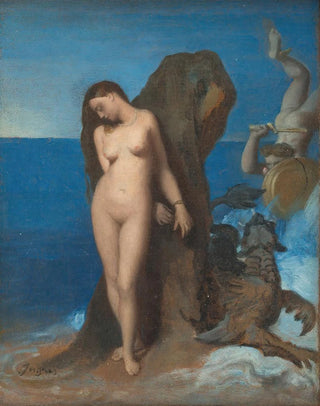Art print | Perseus and Andromeda - Jean-Auguste-Dominique Ingres


View from behind

Frame (optional)
In the fascinating universe of art history, the art print "Perseus and Andromeda" by Jean Auguste Dominique Ingres stands out for its dramatic intensity and timeless beauty. This painting, which depicts a key moment from Greek mythology, captures the hero Perseus in an act of bravery as he rescues the princess Andromeda, chained to a rock and about to be devoured by a sea monster. The scene, filled with tension and passion, invites the viewer to immerse themselves in a mythological story where love and courage intertwine. Ingres, with his mastery of drawing and sensitivity to color, manages to bring to life figures imbued with grace and power, transforming an ancient legend into an art print that continues to fascinate.
Style and uniqueness of the work
Ingres's style is characterized by precise line work and meticulous attention to detail, which is fully evident in "Perseus and Andromeda". The composition of the art print is carefully orchestrated, with the bodies of the characters rendered with palpable sensuality, while the drapery of the fabrics appears almost alive. The colors, though delicate, are applied with such mastery that they give the scene emotional depth. Light also plays a crucial role, illuminating Perseus's face with an intensity that highlights his determination, while Andromeda, vulnerable, is enveloped in shadows that emphasize her despair. Ingres succeeds in creating a harmonious balance between movement and stillness, strength and fragility, giving the art print a captivating dynamism.
The artist and his influence
Jean Auguste Dominique Ingres, an emblematic figure of Neoclassicism, skillfully combined tradition and innovation throughout his career. Trained at the Académie des Beaux-Arts, he was deeply influenced by Renaissance masters, notably Raphael, but also developed a style that is uniquely his own. His works, often rich in mythological or historical references, reflect a constant pursuit of ideal beauty. Ingres played a key role in the transition

Matte finish

View from behind

Frame (optional)
In the fascinating universe of art history, the art print "Perseus and Andromeda" by Jean Auguste Dominique Ingres stands out for its dramatic intensity and timeless beauty. This painting, which depicts a key moment from Greek mythology, captures the hero Perseus in an act of bravery as he rescues the princess Andromeda, chained to a rock and about to be devoured by a sea monster. The scene, filled with tension and passion, invites the viewer to immerse themselves in a mythological story where love and courage intertwine. Ingres, with his mastery of drawing and sensitivity to color, manages to bring to life figures imbued with grace and power, transforming an ancient legend into an art print that continues to fascinate.
Style and uniqueness of the work
Ingres's style is characterized by precise line work and meticulous attention to detail, which is fully evident in "Perseus and Andromeda". The composition of the art print is carefully orchestrated, with the bodies of the characters rendered with palpable sensuality, while the drapery of the fabrics appears almost alive. The colors, though delicate, are applied with such mastery that they give the scene emotional depth. Light also plays a crucial role, illuminating Perseus's face with an intensity that highlights his determination, while Andromeda, vulnerable, is enveloped in shadows that emphasize her despair. Ingres succeeds in creating a harmonious balance between movement and stillness, strength and fragility, giving the art print a captivating dynamism.
The artist and his influence
Jean Auguste Dominique Ingres, an emblematic figure of Neoclassicism, skillfully combined tradition and innovation throughout his career. Trained at the Académie des Beaux-Arts, he was deeply influenced by Renaissance masters, notably Raphael, but also developed a style that is uniquely his own. His works, often rich in mythological or historical references, reflect a constant pursuit of ideal beauty. Ingres played a key role in the transition






